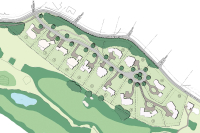Pretrial program nears end of pilot year

Haywood and Jackson counties have been participating in an important pilot program this year in hopes of creating a more fair and swift court process in the judicial district.
At the beginning of 2019, Judicial District 30B — which encompasses Haywood and Jackson counties — began a pretrial release program with the goals of reducing the local jail population, decreasing recidivism rates and increasing the efficiency of the court system.
According to the Pretrial Justice Institute, six out of 10 people sitting in jail — nearly half a million on any given day — are awaiting trial. Many accused low-level offenders stay in jail until their court date because they can’t afford to pay their cash bond, which can range from $200 to thousands of dollars depending on the offense, and not because they are a public safety or flight risk. All these people in jail awaiting trial are clogging up the court dockets and costing taxpayers millions of dollars a year. Seeing how these problems were impacting the system, Superior Court Judge Bradley Letts was instrumental in getting this program implemented.
“No one is being soft on crime. We want to be smart on crime,” Letts told The Smoky Mountain News last year. “This will provide stability and safety for the community but in a thoughtful way while also being mindful of the costs for the county and taxpayers.”
With third quarter analytical results being released in late November, it appears the pretrial program is making progress toward those intended goals but also seeing some unintentional side effects as 2019 comes to a close.
Related Items
Pretrial services
Providing more pretrial services for people awaiting a court date has been a key component of bipartisan criminal justice reform efforts across the country as more county governments are faced with overcrowded jails, a backlogged court system and unsustainable budget increases.
A couple examples of other pretrial services available in Haywood County include the LEAD (Law Enforcement Assisted Diversion) program where law enforcement can refer people to mental health or addiction support before they are arrested and having peer support specialists working with inmates inside the jail to help them connect with the services they need.
The pretrial release program is just one more proactive effort being made to get a handle on the increasing numbers of people facing low-level charges — mostly due to addiction — and trying to get them the help they need as opposed to locking them up without rehabilitation.
“I think there is a lot of movement on pretrial reform in N.C. right now,” said Jamie Vaske, an associate professor at Western Carolina University who’s leading the pretrial release project’s evaluation component. “In Western N.C. we see Buncombe County experimenting with comprehensive pretrial reform, via their Safety and Justice MacArthur Grant, and Catawba County is partnering with MacArthur for implementation of the Public Safety Assessment. It will be interesting to see whether the data supports the use of these programs or not.”
The Criminal Justice Innovation Lab at the University of North Carolina at Chapel Hill is also closely evaluating the data and analyzing the outcomes from the first year. The hope is that the program is successful at meeting its goals and can be duplicated in other judicial districts in the state.

Pretrial release
The pretrial release program for Haywood and Jackson has several components. First, it put into place a new decision-making framework for law enforcement and judges to use when it comes to issuing citations and setting bonds. Participating law enforcement were given a Cite or Arrest Pocket Card meant to encourage the increased use of citations instead of an arrest for certain misdemeanors and the issuing of summons instead of warrants. The program also included updating the old Local Bail Policy magistrate judges use to determine how to set someone’s bond.
“JD 30B’s old Local Bail Policy included a table setting suggested bond amounts based on the punishment class of the charged offense. Best practices recommend against the use of such tables,” Vaske wrote in her analysis. “Additionally, stakeholders determined that although the current charge’s offense class is relevant to the bail decision, other individualized factors regarding the defendant and the circumstances of the offense are important in assessing appropriate pretrial release conditions.”
She said stakeholders also found the old bail policy pushed magistrates toward issuing more secured bonds even though that contradicts state policies that say people should be released on an unsecured bond, written promise or custody release unless they are a flight risk or pose a public safety danger. By limiting the number of secured bonds, the court system can ensure people aren’t being held pretrial simply because they don’t have the financial means to pay their bail.
The new stakeholder-created framework helps magistrates quickly identify low-risk defendants who can immediately be released on non-financial conditions while also recommending maximum bond amounts for secured bonds. It requires magistrates to provide documentation of reasoning if they choose to deviate from the framework and impose a secured bond.
Secondly, the pretrial program puts an emphasis on making sure pretrial detainees have quicker access to a first appearance in District Court. Current law requires a first appearance for in-custody felony defendants within 96 hours of being taken into custody, but the reform program requires defendants charged with misdemeanors and Class H and I felonies to have a first appearance within 72 hours of arrest or at the first regular session of the District Court in the county, whichever occurs first.
“Because the law does not require first appearances for in-custody misdemeanor defendants, these defendants may sit in jail for weeks or more until their first court date,” Vaske reported. “This can lead to scenarios where misdemeanor defendants are incarcerated pretrial when the charged offense cannot result in a custodial sentence upon conviction or where they are incarcerated pretrial for a longer period than they could receive in a custodial sentence if convicted.”
Research also shows that keeping low-level defendants detained pretrial has negative public safety consequences and negative case outcomes for defendants. In order to get pretrial inmates to a quicker first appearance, the Indigent Defense Services Office of North Carolina worked to recruit enough lawyers in the district willing to take on a new role offered to indigent defendants. Otherwise, detainees might not even meet their court-appointed attorney until the moment they appear before the judge, which means the case is often continued for another month or two.
Only a few lawyers signed up and they take turns being the “first appearance” lawyer in District Court on certain days. The first appearance lawyer’s job is to meet with as many defendants in the morning as possible to collect as much information as they can about the case before appearing before a judge to try to get a pretrial release for the defendant. These lawyers are paid under a contract through IDS.
“Early involvement of counsel at pretrial proceedings will better inform judges’ pretrial decisions and protect defendants’ rights in light of the significant consequences associated with pretrial detention,” Vaske wrote. “Early involvement of counsel is recommended by national standards and has been specifically recommended for North Carolina.”
For those defendants intentionally detained on unattainably high secured bonds because of concerns about public safety or flight risk, the new bail policy was revised to provide the defendant with a detention bond hearing. At that hearing, defendants are provided with constitutional procedural protections, including the right to counsel, the right to present evidence, and proof by the state that no conditions of release can reasonably assure safety, appearance and protection of the judicial process.
Results
The first nine months of data show that the program is seeing improvements within the system, specifically with fewer secured bonds and more non-financial conditions for pretrial release, fewer pretrial bookings at the jails and shorter jail stays for those who are booked pretrial.
The percent of non-financial conditions issued during the first three quarters of 2019 was 18.61 percentage points higher than the percent issued during the same period in 2018. During the same timeframe, there was a significant decrease in secured bonds issued — from 60.84 percent of cases to 41.80 percent.
The data shows that the number of admissions into the Haywood County jail was, on average, 3.97 percent lower in 2019 compared to 2018. The number of pretrial bookings was higher for the months of January, May, June, and July 2019, relative to the same period in in 2018.
Vaske’s analysis also examines the rates of people who fail to appear for their court date during the first nine months of the program. On average, the percentage of defendants who failed to appear is 2.57 percentage points higher in 2019 compared to 2018. The percentage of defendants failing to appear has slightly increased: the average court appearance rate was 81.37 percent in 2018 and 78.79 percent in 2019 for Jackson County. Analysis of the 2019 court calendars show that a large number of nonappearances in July and August 2019 account for the substantial increase in non-appearance rate.
“We do see a slight increase in non-appearances — 2.57 percent increase for Jackson and 1.41 percent increase for Haywood — although 80 percent of people are showing up to court as required and this has not changed,” Vaske said. “I think it’s important to put it in context. We have seen similar increases in non-appearances in Charlotte after they implemented their reforms. Also, when we look to see where non-appearances have increased, we see increases in non-appearances on the traffic calendars in both counties.”
She said the question for stakeholders will be whether these 1 to 3 percent increases in non-appearances and the extra time involved for the project are worth it. When it comes to continuing the program next year, Vaske said that will be completely up to Judge Letts. Letts has not responded to emails seeking comment on the program’s first year.
“I think the jail data are showing a decrease in long term pretrial detention relative to the previous year. Also, the recent ACLU lawsuit against Alamance County draws attention to bail practices in N.C., especially rural jurisdictions,” she said. “There are a host of additional considerations as well — protecting constitutional rights, citizens’ perceptions of these programs and feelings of safety, etc.”
To view the complete third quarter progress report, visit https://cjil.sog.unc.edu/files/2019/11/Third-quarter-implementation-results.pdf.













